Computers
Lenovo ThinkPad X1 Carbon, analysis: a “pure strain” ThinkPad determined to make it very difficult for its competitors
Published
5 years agoon
By
Harry Watson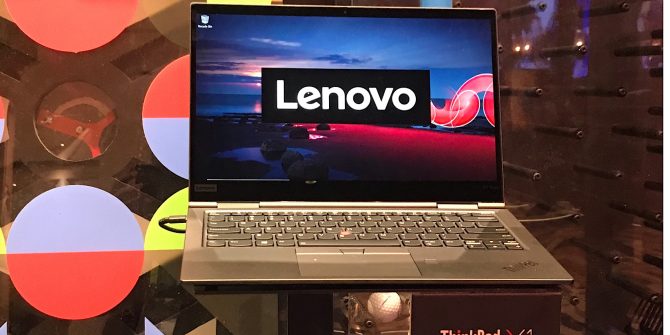
The ThinkPads have been laptops with a very strong character for almost three decades. They were when the brand belonged to IBM, and they still are now in the hands of Lenovo. And, without a doubt, it is good news. It is very likely that his sober design does not please everyone, but defends a continuity over time in line with his professional vocation , and, above all, with his intention to stay out of temporary trends.
The ThinkPad X1 Carbon to which we dedicate this analysis belongs to the sixth, and, for the moment, the last generation of this model. All the hallmarks of the ThinkPad family , such as the characteristic red pointer housed in the center of the keyboard, are present in this computer, which, as expected, has been updated with the latest components. But its real distinguishing feature, beyond its design, is its construction in carbon fiber and magnesium alloy . And it is not only made to last; also to not leave anyone indifferent.
Lenovo ThinkPad X1 Carbon: technical specifications
The version of this laptop that Lenovo has given us for this analysis is governed by a microprocessor Intel Core i7-8550U eighth generation equipped with four cores and can simultaneously process up to 8 threads ( threads ). This is the intermediate model of the ThinkPad X1 Carbon family because there is a version of this same laptop equipped with a processor Intel Core i5 a little slower, and also another with a chip Core i7 slightly faster. In any case, the important thing is that they are all Intel Core 8-generation microprocessors .
The unit that we have analyzed incorporates 16 GB of main memory of type LPDDR3 to 2.133 MHz effective, although the most economical version of this laptop has 8 GB of the same type. The DDR ( Double Data Rate ) memory chips are activated twice during each cycle of the clock signal (by flank or by level), hence the real frequency of the signal that marks the work rate is just half of the time. number indicated by the memory modules. This is the reason why it is important to distinguish the effective clock frequency from the actual frequency. The first in the DDR type memory modules is always twice the second thanks to the double activation of the chips in each clock cycle.
This laptop does not have a dedicated graphics processor, so the graphic logic that is responsible for generating the video signal that will receive the screen is inside the CPU. The graphics that incorporates the Core i7 chip of this equipment are the Intel UHD Graphics 620 , a solution that we have tested in other laptops with an eighth generation Intel processor and that fits well with the graphics performance we can expect from a professional laptop .
The DDR memory chips are activated twice during each cycle of the clock signal, either by rising or falling edge, either by high or low level, hence it makes sense to talk about effective clock frequency
Lenovo sells this device with four different screens , although all of them have 14 inches. Two have WQHD resolution (2,560 x 1,440 points) and the other two are Full HD (1,920 x 1,080 pixels). The most ambitious WQHD model has a maximum brightness delivery capacity of 500 nits and is compatible with Dolby Vision content , but this is not the screen that incorporates the laptop that we have had the opportunity to analyze. The ThinkPad we have tested has a Full HD IPS LCD screen with a brightness delivery capacity of 300 nits and no touch capabilities (there is also a touch version with the same features).
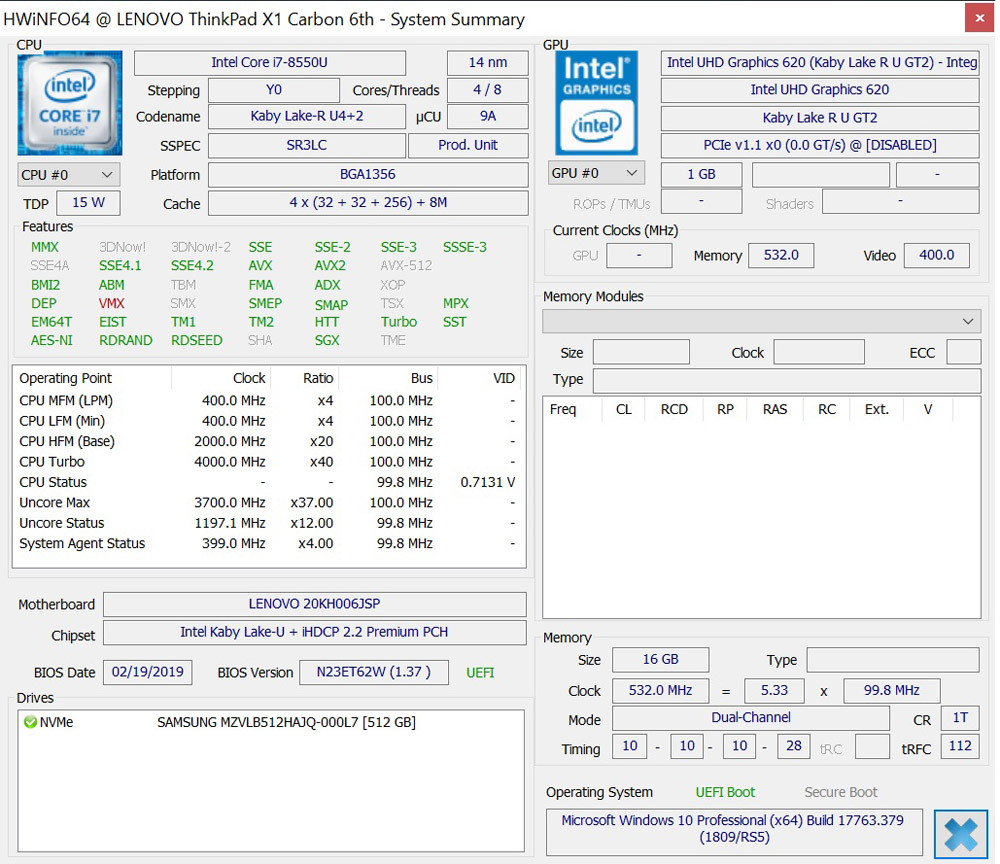
Solving the secondary storage of this laptop is responsible for an SSD unit manufactured by Samsung with a capacity of 512 GB and interface NVMe M.2 . The most economical version of this ThinkPad has a SSD of 256 GB, and the most ambitious incorporates a 1 TB, but all of them offer comparable features. Yes, the capacity of these units has a significant impact on the price of the equipment, so the version of 512 GB is on paper the most interesting if our budget does not allow us to opt for the unit of 1 TB.
As far as connectivity is concerned, it is worthwhile to look at the two Thunderbolt 3 ports via USB type C that this device has, and that are added to two others of type USB 3.0. The controller that allows access to wireless networks is compatible with the WiFi 802.11ac standard and implements MIMO 2×2 (it has two antennas that can be used simultaneously to send and receive data).
| LENOVO THINKPAD X1 CARBON | FEATURES |
|---|---|
| SCREEN | IPS Full HD 14 inch and 300 nits LCD |
| RESOLUTION | 1,920 x 1,080 points |
| PROCESSOR | Intel Core i7-8550U of eighth generation (4 cores, 8 threads of execution, 14 nm, base frequency of 1.80 GHz, maximum frequency of 4 GHz and L3 cache of 8 MB) |
| RAM | 16 GB LPDDR3 at 2.133 MHz |
| GRAPHICS | Intel UHD Graphics 620 |
| STORAGE | SSD Samsung 512 GB NVMe M.2 |
| SOUND | Dolby Atmos with headphones Long-range dual array microphones with 360 ° noise cancellation |
| OS | Windows 10 Pro |
| CONNECTIVITY | 2 x Thunderbolt 3, 2 x USB 3.0, 1 x HDMI, 1 x combo headphone / microphone input and 1 x proprietary Ethernet connector 1 x 802.11ac MIMO 2×2 WiFi and SD / SIM card slot and Bluetooth 4.2 |
| CAMERA | HD 720p with ThinkShutter |
| SECURITY | Fingerprint reader touch with technology Match on Chip and protection against forgery Authentication FIDO (Fast Identity Online) integrated Windows Hello with software facial recognition (needs IR camera) or fingerprint reader |
| DRUMS | Lithium polymer / 57 Wh with fast charge |
| DIMENSIONS | 323.5 x 217.1 x 15.95 mm |
| WEIGHT | 1,13 kg |
| PRICE | 2,387.17 euros |
Finishing and materials: in the first division on its own merits
As I have advanced in the first paragraphs of the analysis, one of the strongest strengths of this ThinkPad is its construction. And it has an internal structure of four layers of carbon fiber that is as hard and rigid as steel, and, at the same time, as light as plastic. This support is the skeleton of the laptop, and, therefore, the structure to which the main base plate and the other components of the equipment are fixed. Precisely the lightness of the carbon fiber is largely responsible for the low weight of this laptop (weighs only 1.13 kg despite having a 14-inch screen).
The interesting thing is that Lenovo has not opted for a material with attractive mechanical properties only when it comes to tuning the chassis of the team. The outer case of the laptop is made of magnesium alloy , a light, rigid and resistant material that guarantees protection against impacts and very noticeable deformation. The cost of both carbon fiber and magnesium alloy is high, and obviously has a clear impact on the price of the equipment, but a bet like this makes sense in a professional laptop designed to accompany us wherever we need to take it and without demanding that we be especially careful with him.
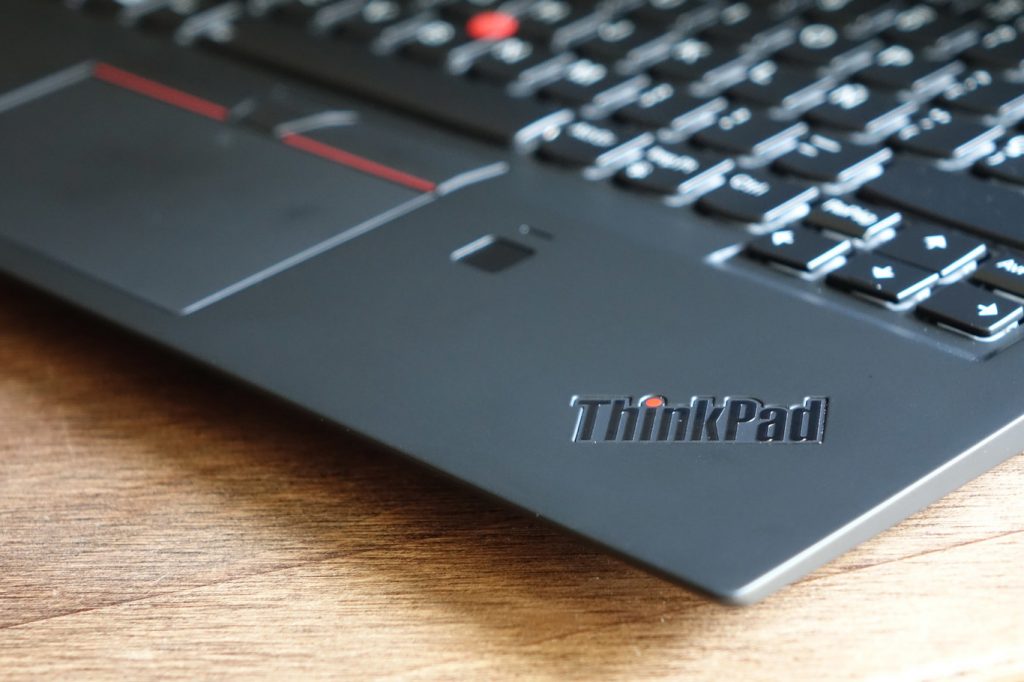
As regards the finishing of this ThinkPad, the photographs that illustrate this article speak for themselves. The machining of the outer box is impeccable and uses a unibody design to reduce as much as possible the number of joints and areas that could weigh the impact absorption capacity of the equipment. In addition, the magnesium alloy case has a very nice touch and a slight roughness that allows us to grip it firmly using only one hand and without giving the feeling that it can slide towards the ground at any time.
If we stick to its design I have little to add to what I anticipated in the first paragraphs of the analysis. Lenovo has opted to preserve the sober, minimalist and no-frills aesthetic that is so characteristic of ThinkPads since industrial designer Richard Sapper proposed his original design in the distant of 1992. I know that it is a design that is not liked by everybody, but also that has followers seduced by this aesthetic so timeless . In any case, this design is one of the hallmarks of the ThinkPad family and it seems unlikely that Lenovo will modify it substantially in the future.
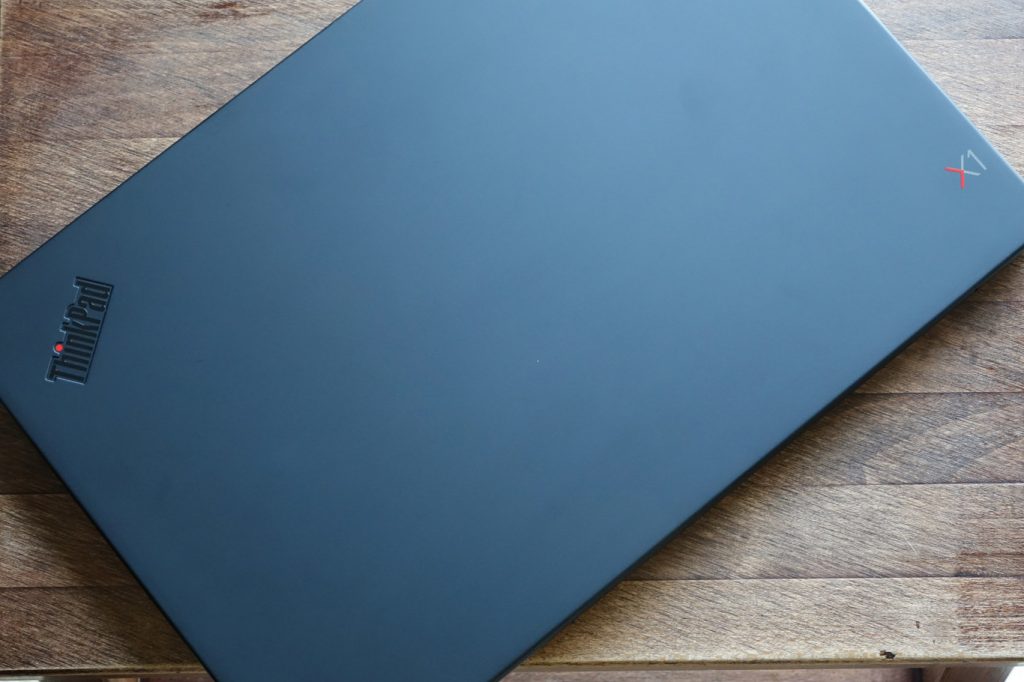
Experience of use: a laptop convinced of his professional vocation
In the following image you can see that the frames of the screen are quite thin (the top measures 10 mm and the sides 5 mm), which reminds us that sobriety and modernity can go hand in hand without major problem. In fact, despite its discretion this ThinkPad does not look like an old computer at all. To test the quality of the IPS Full HD panel of this laptop, I used my usual test tools: White Screen Page and DisplayMate . Many IPS panels suffer from light leaks, especially at the corners, but during the tests I did not notice any leakage that could affect our experience, so this first test was passed with good marks.
With regard to color reproduction and viewing angles, which are the two strong points of the IPS panels, this screen behaves as expected. It is not the best IPS panel that I have tested at all, but it restores colors with precision, with a homogeneous luminosity on the entire surface of the panel and with a convincing contrast. In addition, it has a matte finish that effectively minimizes reflectionspropitiated by environmental light. Although, yes, the resolution Full HD (1,920 x 1,080 points) in my opinion is a bit short for a panel of 14 inches. The space available on the desktop to work is sufficient, but I would have appreciated having one of the panels with WQHD resolution (2,560 x 1,440 pixels) that also equip these ThinkPad X1 Carbon. Although, as expected, they are more expensive than this version.
Interestingly, the hinges that are responsible for fixing the screen to the main box of the team surprised me pleasantly. They are surprisingly small, and for this reason I expected them to suffer from a certain fragility. But no. They are small, but they are not fragile. And do not reveal any type of slack when folding and unfolding the screen, so there is no indication that it seems to indicate that this could be a possible point of failure derived from intensive use in the long term.
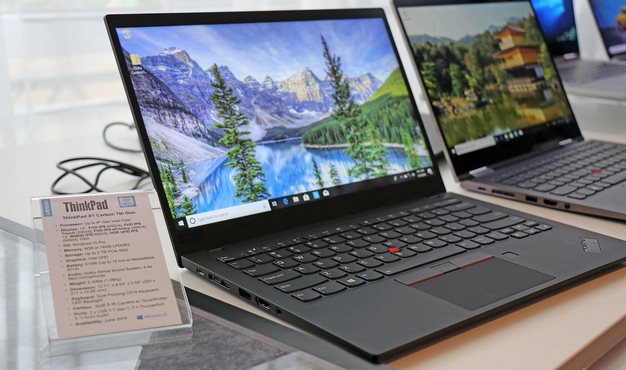
The keyboard of this ThinkPad has left a very pleasant taste in my mouth. I like the touch and the route of the keys, which is noticeably greater than that of traditional chiclet keyboards , and this makes it very desirable to face long writing sessions. However, the keys suffer from a slight transverse oscillation , possibly derived from their relatively long travel. In any case, it is not at all dramatic at all and is to a certain extent compensated by that route which, honestly, I find very pleasant. Another point in his favor: the size of all the keys is generous, making it more difficult to make mistakes than on the keyboard of other laptops with smaller keys.
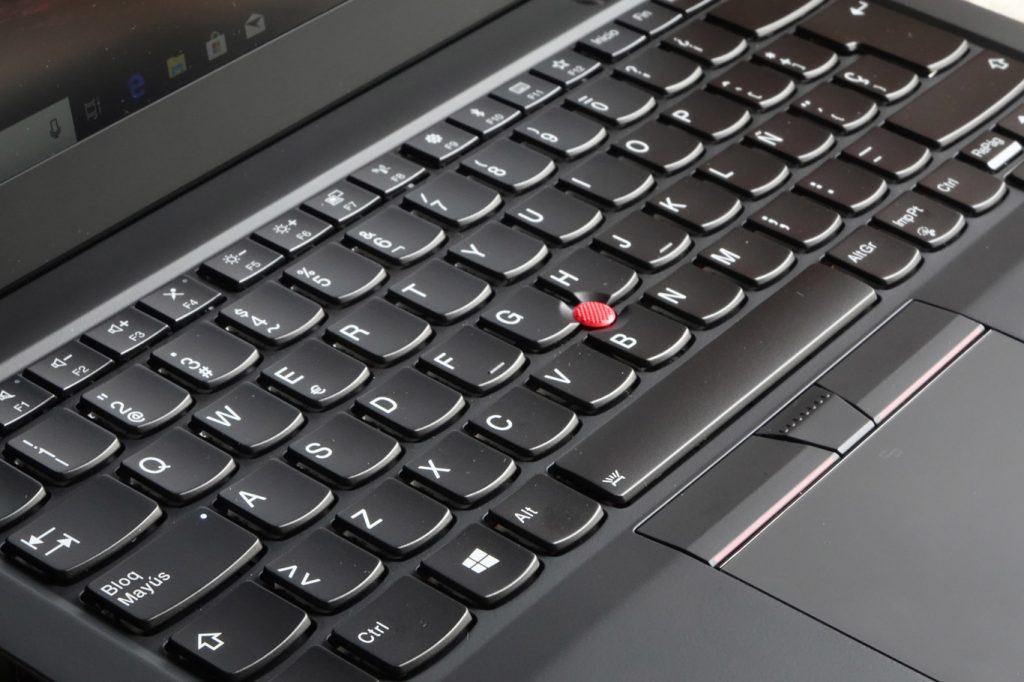
The touchpad , on the other hand, is not oversized because just above it reside the buttons that will be used by users who prefer to use the traditional red ThinkPad pointer to act on the position of the mouse. It is the price to pay for incorporating this double option of pointer control, but once you get used to the size of the touchpad , which is not too small, there is no major problem. And, yes, the red “pinganillo” has a certain charm because it leaves no doubt that this team is a ThinkPad of pure strain .
To the right of the touchpad resides the reader of fingerprints, a very important element in a team that has a professional vocation as marked as that of this portable computer. Lenovo says that this component is associated with a chip that implements a technology designed to prevent unwanted access , a feature that will probably please the system administrators responsible for ensuring, among other things, the privacy of the data contained in the equipment. of the company for which they work.
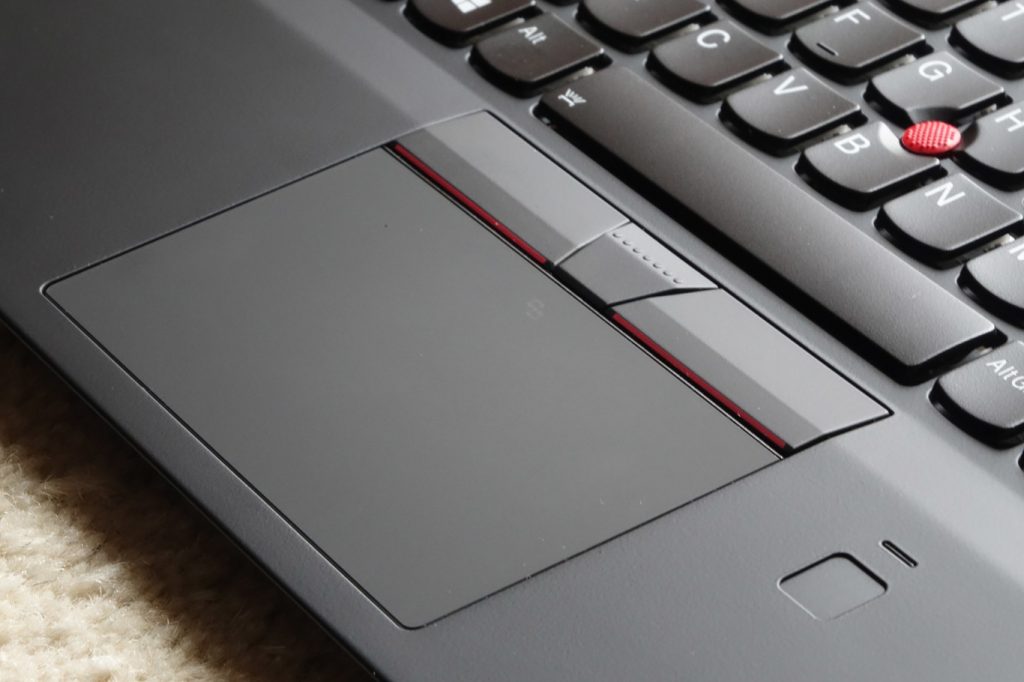
The connectivity of this equipment is reasonably well resolved, especially if we bear in mind that the case of the laptop has a thickness of only 10 mm. It incorporates two ports Thunderbolt 3 encapsulated in two connectors USB of type C, other so many USB 3.0, a slot for an SD card or SIM, the pertinent exit HDMI and a closing of type Kensington. What it does not have is an RJ-45 connector that allows us to connect it to a local area network using an Ethernet cable, but Lenovo offers us, along with the equipment, an adapter that is connected to the proprietary port that you can see in the following picture , and that adds the RJ-45 portwhich possibly some users will take advantage. It is appreciated that this accessory comes as standard and that in a high-end equipment like this, which has a high price, do not have to buy it separately.
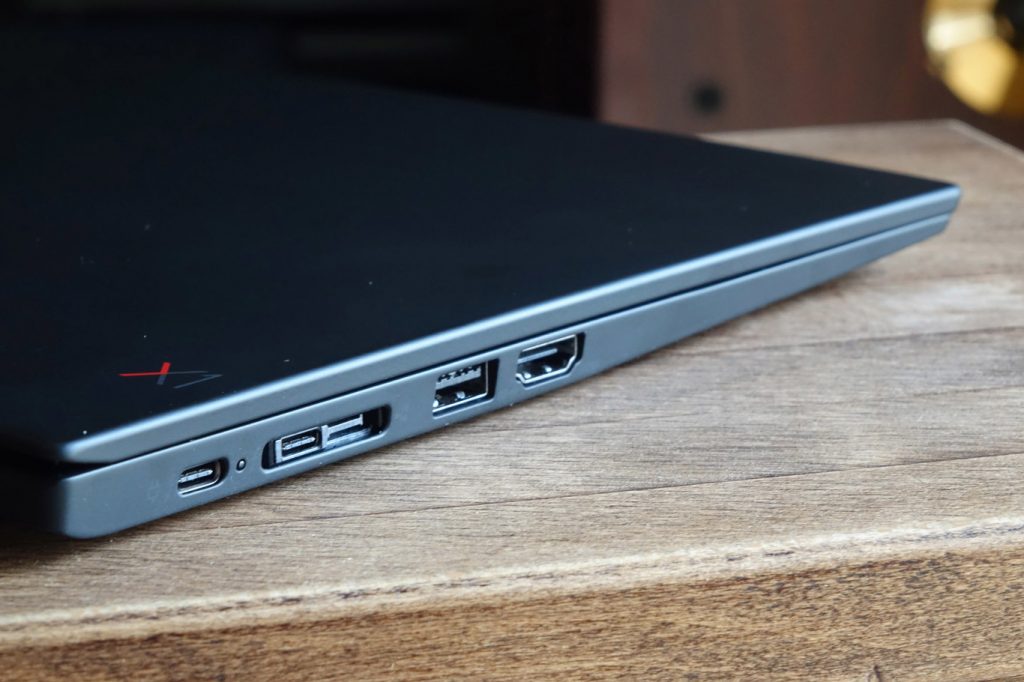
A feature that will undoubtedly interest users who are more jealous when it comes to their privacy is the small cap that allows us to hide the webcamhoused in the top frame of the screen. To prevent the webcam fromrecording us without our consent, we only have to move a tab that blocks it mechanically, so this mechanism can only be “neutralized” by physically accessing the device. It is a simple solution, yes, but, at the same time, it is effective.
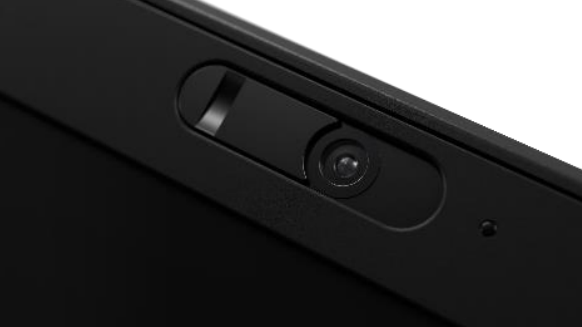
Our test bench
The performance of this ThinkPad X1 Carbon in Cinebench R15 is aligned with the one that has thrown in this test the other machines that also bet on an Intel Core i7-8550U microprocessor that we have analyzed. As expected, other Core i7 processors that are older but capable of processing the same number of threads and with a higher clock frequency, have surpassed it. Even so, the result obtained by this team in this test is sufficient for the eminently professional use scenario in which it feels most comfortable.
The performance of this ThinkPad X1 Carbon in Cinebench R15 is aligned with the one that has thrown in this test the other machines that also bet on an Intel Core i7-8550U microprocessor that we have analyzed. As expected, other Core i7 processors that are older but capable of processing the same number of threads and with a higher clock frequency, have surpassed it. Even so, the result obtained by this team in this test is sufficient for the eminently professional use scenario in which it feels most comfortable.
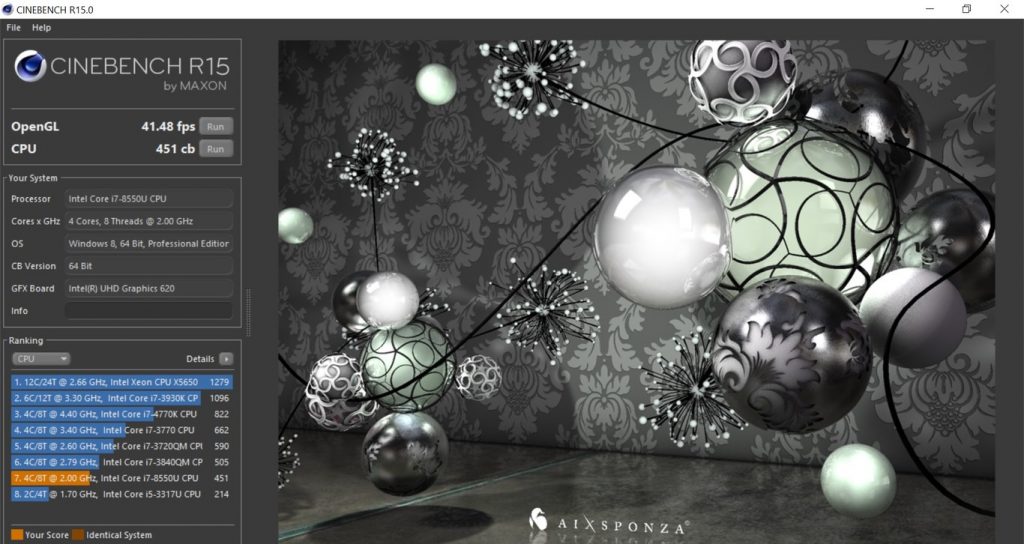
In PCMark10 , a test that reflects how this team performs in a scenario that combines office tools and content creation, is placed between the super Xiaomi My Laptop Air , which incorporates an Intel Core i5-8250U, and Yoga 730 of the own Lenovo , that resorts to the same processor of this ThinkPad. The experience offered by teams that exceed 3,000 points in this test is usually satifactory, so although there are clearly faster machines, as we can see in the graph, the performance in this test of this equipment is sufficient.
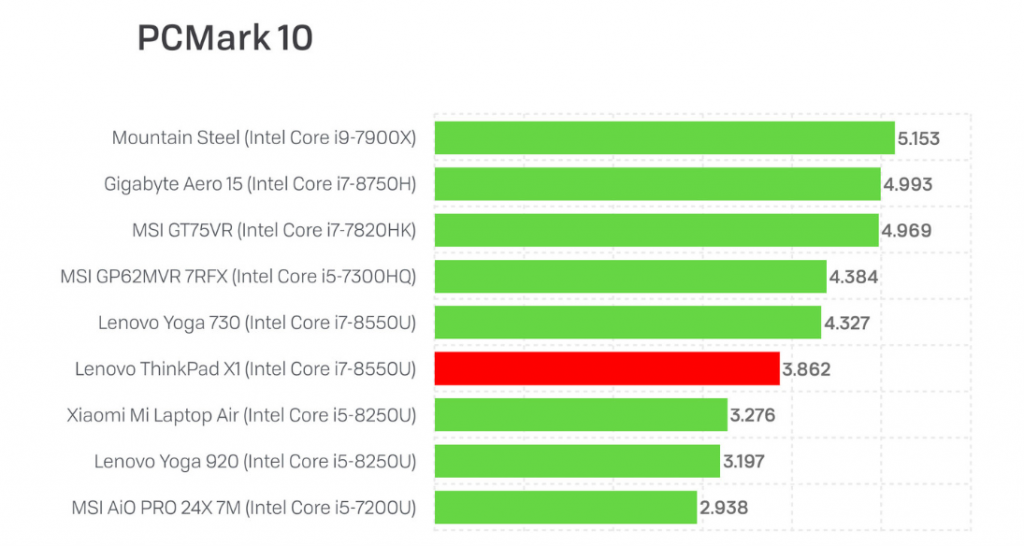
The result that has been thrown in the Home Conventional 3.0 scenario of PCMark 8 is similar to what this team has achieved in the previous test. However, in this test it has slightly surpassed two machines that incorporate the same CPU as this ThinkPad, such as the Yoga 730 from Lenovo and the Specter x360 from HP . The difference in performance in this test between these three machines is small and is favored by the impact that other components have on productivity, but any of them can be faced with guarantees to an office environment and content reproduction.
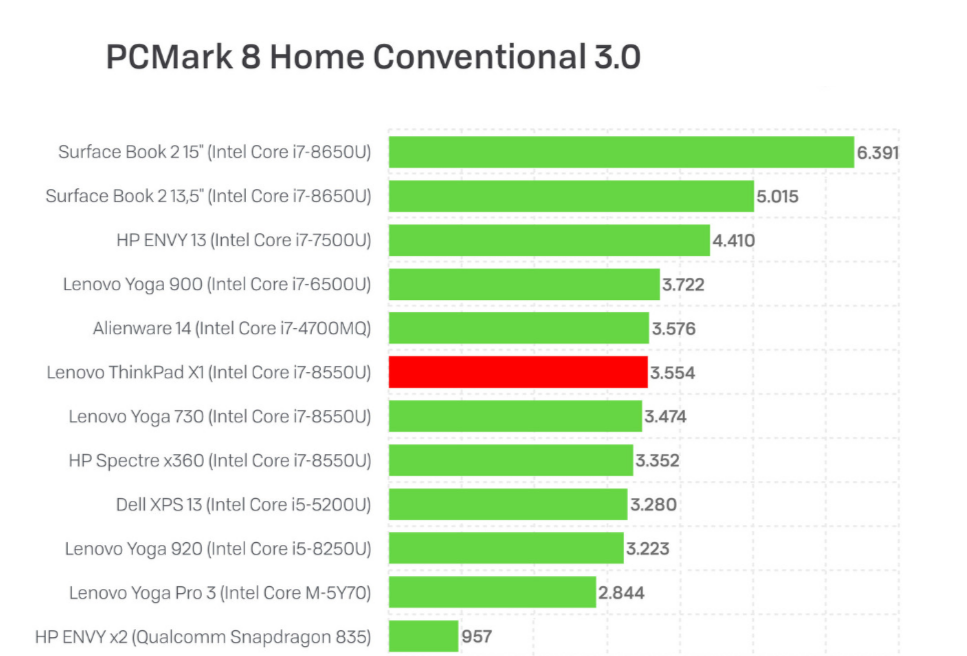
In the PCMark 8 Creative Conventional 3.0 test , which evaluates the team’s performance in a content creation scenario, it has been the same as in the previous two: it does not stand out, but it offers us a productivity aligned with what we can demand from a professional laptop designed to perform well in an eminently office environment, reproduction and creation of content. It works reasonably well in a multitasking environment of some intensity, so I have nothing to object to in this context.
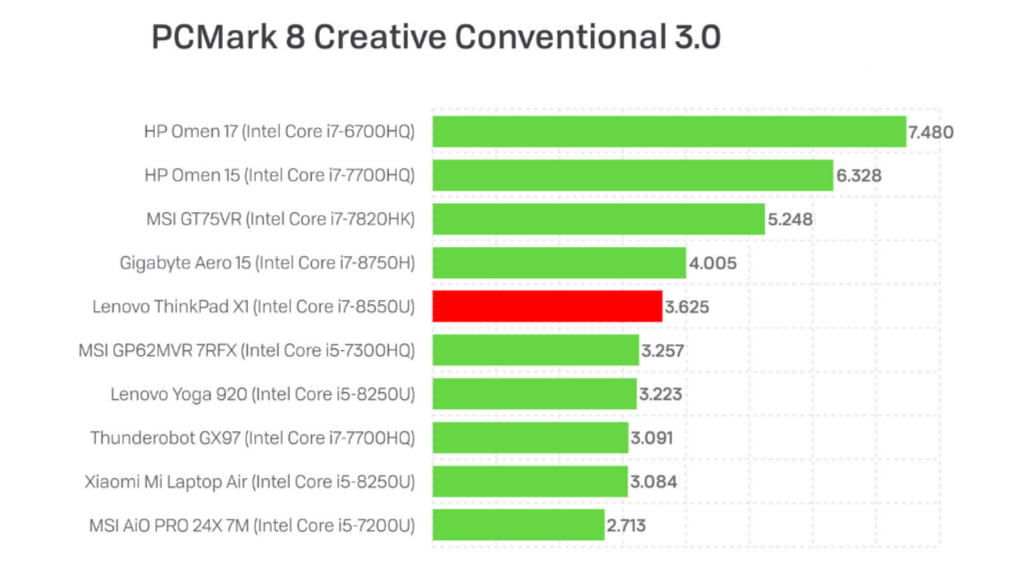
As you can see in the following screenshot, the SSD unit with NVMe M.2 interface manufactured by Samsung with this laptop has a great performance. In CrystalDiskMark 6.0.2 it has thrown more than 3,300 MB / s in sequential read operations, and almost 2,000 MB / s in sequential write operations. These two figures are great. In fact, they surpass the numbers thrown by other SSD units of the same capacity and with the same interface, which leaves this storage solution from Samsung in a very good place.
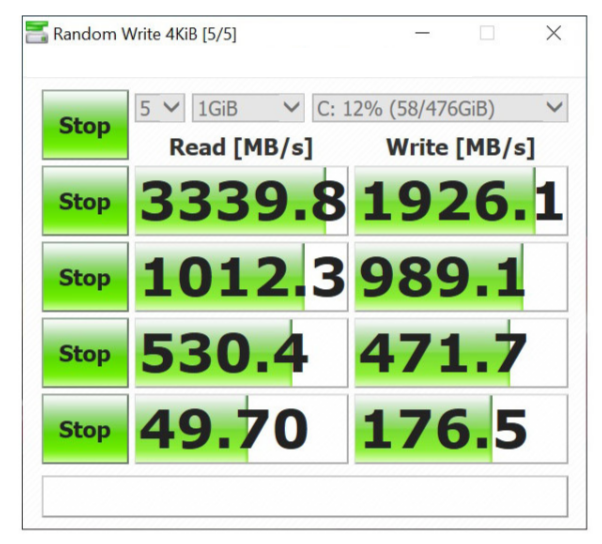
Finally, we come to one of the critical tests that we have submitted to this team. In real conditions of use and in a scenario that combines office tools, Internet browsing, content creation and reproduction, its autonomy ranges between 6.5 and 7.5 hours , depending on the stress to which we submit it. These figures are far from the maximum 15 hours announced by Lenovo, but reflect that in real use conditions is close to the duration of a full standard working day, so in this area does not shine, but does not go bad.
During our tests, the maximum temperature reached by the Intel CPU package was 63 degrees Celsius , a very moderate value that is clearly below the maximum temperature threshold of this microprocessor. It is clear that cooling is not a problem for this laptop. And its noise emission level either. To measure it I used my usual Velleman DVM805 sound level meter, and the maximum noise never exceeded 36 dB , which is a very low and practically inaudible value.
Lenovo ThinkPad X1 Carbon: the opinion and note of Xataka
After testing it thoroughly for two weeks and subjecting it to considerable stress, I have no doubt that this is a pure strain ThinkPad. Its most attractive asset, in my opinion, is its very careful construction in carbon fiber and magnesium alloy. I also like how well-connected their connectivity is (the two C-type USB ports that are compatible with Thunderbolt 3 are a guarantee of versatility for the future), and how light it is. In fact, its weight of just over 1.10 kg means that it is not lazy to take it anywhere. And I have also left a good taste in my mouth the little that is heated and its very low level of noise emission.
It is perfect? No, it is not. The most important “snag” I put to this team is the resolution of its panel. Not working wrong with a 14-inch Full HD screen, but I would bet without hesitation for one of the versions of this team that have a panel with WQHD resolution . The desktop gains in breadth, and we can also see more information at a glance when we use, for example, a spreadsheet or a database. In my opinion, the additional payment required by the WQHD screen version is worth it, if we can assume it (going from the Full HD panel to the WQHD costs 107.69 euros).
The other two small “sticks” that I put are caused by the slight transverse oscillation of the keys, and also by a touchpad that, in my opinion, should be somewhat larger. Even so, I recognize that I could live with them without much trouble, especially considering that the experience that this laptop offers us is very satisfactory if, first of all, we value its constructive quality and its portability . This is clear evidence that Lenovo continues to bet for its ThinkPad range for the same values that IBM defended during the decades in which this brand belonged.
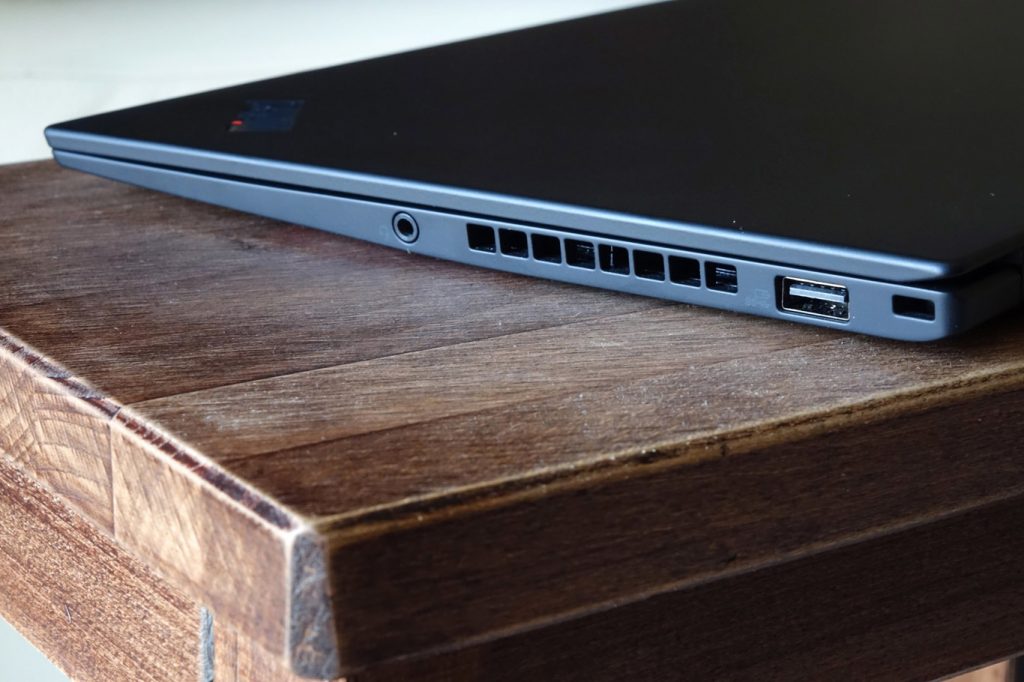
In favor
- Its construction in carbon fiber and magnesium alloy is outstanding
- It has a very well connected connectivity despite its reduced thickness
- Its lightness (barely weighs 1.13 kg) positions it as a true ultralight
- It barely heats up and emits a very low level of noise
Against
- The Full HD resolution of the 14 “screen is somewhat short, it is preferable to bet on the version with WQHD panel
- The keys suffer from a slight transverse oscillation
- The touchpad is smaller than the one incorporated by other laptops with a similar size
You may like
-


Habemus trail: Harley-Davidson Pan America to start production in February
-
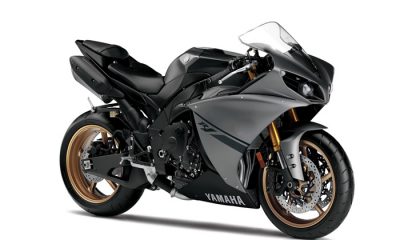

Motorama 2021 wants to fill the pavilion of the Casa de Campo in Madrid with motorcycles between May 7 and 9
-


Amazon Sidewalk wants to connect your Amazon Echo with those of your neighbors, and will do so unless you do not deactivate that option
-
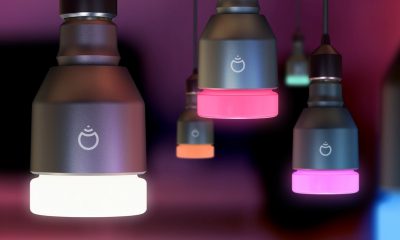

When hacking a smart light bulb can steal your WiFi password and private information in less than an hour
-


Europe steps on the accelerator with the coronavirus vaccine and the European Medicines Agency advances the meeting to December 21 to give the go-ahead
-


Artificial intelligence helps us make tough decisions, but we tend to allow (and prefer) it to decide for us

